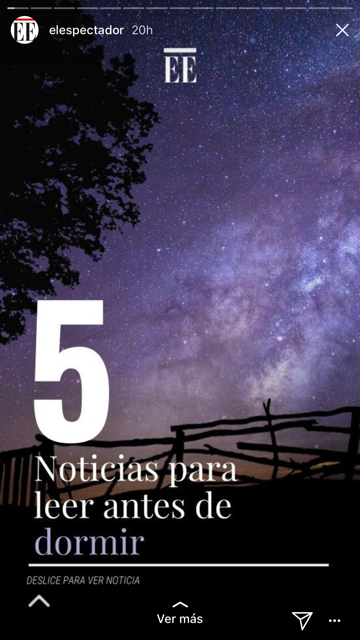Mark Zuckerberg announced Instagram Stories on August 2, 2016. By October 2016, it had 100 million daily active users. One year later it reached 300 million, compared to Snapchat's 178 million, according to Statista.
These networks are an increasingly popular space to distribute and share news content. Snapchat understood this early, when its team launched Snapchat's Media section, allowing media organizations to access certain tools and features.
When using Instagram Stories, it's essential for media organizations to highlight content quality and post regularly. One of media organizations’ biggest problems using Instagram is their inconsistency.
Last January, we published a series of posts about photojournalism. The sixth installment described ways to use Instagram for photojournalism initiatives. However, it can be used by news organizations for broader stories, as long as they know how.
For a week, we observed the use of Instagram Stories by media organizations around Latin America, including Mexico’s Reforma and El Universal, Guatemala’s Prensa Libre, Guatevisionn and Soy502, Colombia’s El Tiempo, El Espectador and El Universal and Venezuela’s El Nacional. After observing, we collected our findings into a few helpful hints to enhance journalist’s use of Instagram Stories.
The most popular features in Instagram Stories’ are surveys and live broadcasts. Hashtags and locations tend to be less successful. Most journalists that use the platform agree that less content means more audience, as many viewers don’t want to click through an long story.
It’s important to realize that Instagram Stories do not always generate site traffic, but this doesn’t mean they aren’t valuable. Instagram Stories can contribute to brand recognition and introduce a new, interactive form of storytelling.
Use Instagram Stories for outstanding stories with relevant and attractive content. Here are some examples of how to do so:
Feature stories
A feature story published in print or digital may contain very attractive images and data. You can simultaneously build a condensed version of that story and publish it on Instagram. Use five to seven images, a video and a link to the website.
The more photos you add to a story, the fewer people will follow it until the end. So it’s best to add the photo or video you want to highlight in the middle of the story.
News summaries
Curate five relevant news stories that had a lot of traffic on your website and advertise them as “Top 5.” Every news item must have a unique design, including an image and a link. Then you can add them as a featured story on Instagram.
Breaking news
Several media organizations try to attract audiences to their websites by publishing a photo or video of breaking news, with a link to the published story. There are no concrete results yet, but they generate considerable traffic.
Specials
For special events, start a live streaming — but keep it short. If the event has several highlights, it’s better to launch different streamings so that followers receive separate notifications.
If this feature is used well, followers will appreciate it. In at least two publications we followed, two people fed the platform. One was devoted to live streaming and the other posted images and stories. This way you will generate a direct experience and high-quality content.
In Latin America, Instagram and Instagram Stories are still secondary sources of content distribution. However, the number of active users is growing, making it more important for journalists to engage on the platform.
Luis Assardo is a journalist, professor, digital consultant and researcher. He has studied in the United States, Germany and Japan. He has created and directed several digital media startups in Guatemala.
Main image CC-licensed by Flickr, via Mat McGee.




